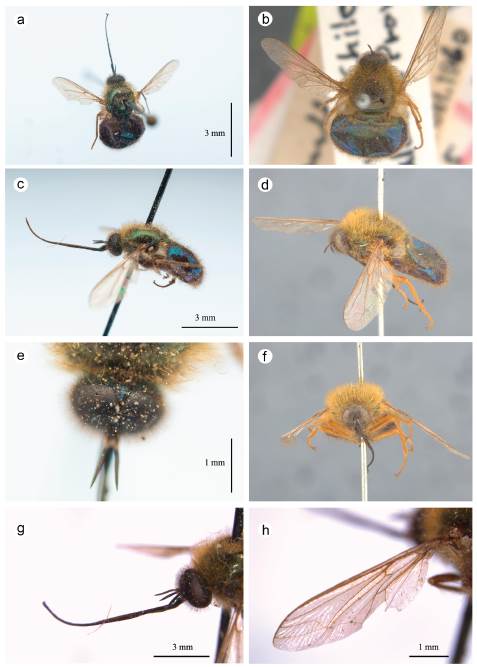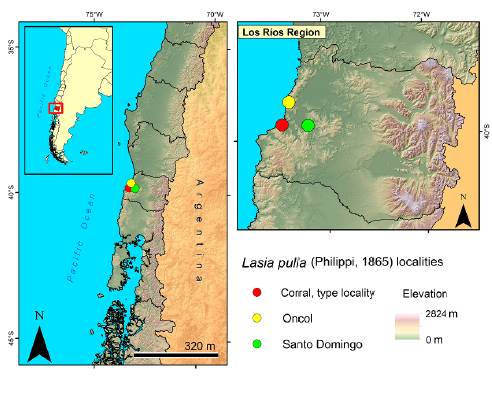Spider flies (Diptera: Acroceridae) is a small family composed of 55 genera and approximately 530 species (Schlinger et al. 2013). This family is recognized because they have endoparasite behavior on spider families (Schlinger 1987, Kerr and Winterton 2008, Barneche et al. 2013, Gillung and Borkent 2017), except for the Chilean genus Carvalhoa with external parasitoids in Amaurobiidae spiders (Schlinger 1987, Schlinger et al. 2013). The subfamily Pa-nopinae attacks principally tarantula spiders and there are only 18 cases recorded to date (Gillung and Borkent 2017).
Neotropical Panopinae, commonly named as 'tarantula flies', include the genus Lasia, which is restricted to the New World (Gillung and Carvalho 2009) and is composed of 16 species distributed from the United States to Chile (Schlinger 2009). Lasia is closely related to Panops (Australia and Papua New Guinea), Apsona (New Zealand), Lasiodes (Peru), Pteropexus, and Eulonchus (North America) (Winterton 2012, Gillung and Winterton 2019). Lasia is distinguished from other New World Panopinae by the insertion of the antennae on the central part of the head, eyes densely pilose with setae, greatly elongate mouthparts, eyes not contiguous below the antenna insertion, and frequently metallic body coloration (Gillung and Carvalho 2009, Gillung and Winterton 2019). Chile has the largest number of described Lasia species in the Neotropical Realm; however, some type specimens described by Philippi (1865) were reported as lost (González et al. 2018, Shaun Winterton pers. comm.). Lasia pulla (Philippi, 1865) (Fig. 1) is the smallest tarantula fly species from Chile; before to this work only the holotype of this species was known (Fig. lb, id, le), restricted to its type locality in Corral, Los Ríos Region (Philippi 1865). In this study, we report the rediscovery of L. pulla from the province of Valdivia, in southern Chile and provide an updated redescription of the species. Aspects about the rediscovery, distribution and conservation of L. pulla are also discussed.
Sampling was conducted in areas with Valdivian evergreen forest near Valdivia city. This forest type extends from the Toltén river (40°50' South) to the Llico river (41°30' South), having a mean temperature of 17.4°C, an annual rainfall up to 5000 mm and it is mostly represented by tree species like Aextoxicum punctatum Ruiz et Pav. and Nothofagus spp. (Smith-Ramirez 2004). Lasia pulla specimens were obtained from two sources: The Ernesto Krahmer collection from Universidad Austral de Chile (UACH) and fieldwork surveys. Previous observa-tions realized by the first author determined a rich assemblage of insects visiting flower patches ofAlstroeme-ria aurea Graham and Fuchsia magellanica Lam. combined with exotic plants as Taraxacum officinale (L.) Webber ex Wigg among others, which are visited mainly by Lasia nigritarsis and other spider flies as Holops and Megalybus species. Then, we performed focal sampling in flowers patches composed mainly of these native shrubs and herbaceous plant species. Sampling span between 2013 and 2019 in several localities: Teja Island (39°48' South, 73°15' West), Punucapa (39°43' South, 73°18' West), Oncol Park (39°40' South, 73°21' West), Corral (39°53' South, 73°25' West), Santo Domingo (39°54' South, 73°8' West) and Llancahue (39°34' South, 71°57' West). Punucapa, Llancahue and Corral were visited at least three times (2014, 2016 and 2017) between two periods: 10-20 November and 12-22 January each year. Days of sampling each year were variable, but we worked three days at minimum. Teja Island, Oncol Park and Santo Domingo were visited all years also in two periods: 5-18 December and 10-25 February each year, also with three days of sampling at minimum. Flies were collected with entomological net in shiny days, sweeping over flowers using ten net passes in each sampling point separated from each other by approximately 2 km (n = 3 times by locality; total sampling = 4 km). In addition, when flies were feeding of nectar in flowers on these patches, we directly caught specimens. Flies were processed each year and preserved (pinned or stored in alcohol 90 %) in the private collection of the first author. A redescription of L. pulla follows the terminology of Cum-ming and Wood (2017). Measurements were taken with a 0.05 mm precision electronic ruler and the scale using a Leica S6 D microscope. Photographs were taken with a Nikon D7200 camera, equipped with AF-S DX MicroNIKKOR 40mm f/2.8G and extension tubes. The distribution map was created using ArcGIS v.10.4.1.
Lasia pulla (Philippi, 1865), Figs. 1a-h
ZooBank LSID: urn:lsid:zoobank. org:pub:AA1A0E98-4369-4765-9A51-AB9FE0D7E4DA
Diagnosis. Bicolored species. Face and vertex of a metallic blue color. Flagellum 8-fold longer than scape or pedicel. Mesonotum shiny green. Lateral thoracic segments of shiny metallic blue-violet color. Legs brownish to dark yellow. Wings membranous and faintly smoky. First and second tergites are metallic blue. The first and second sternites metallic violet. Other tergites and sternites shiny blue-violet. The whole body is covered with a golden-yellowish pile. Wing vein M2 present.
Redescription. Body: Length: 6.92-7.50 mm (Figs. 1a-b); thorax width: 3.87-4.10 mm; abdomen width: 4.19-4.59 mm; wing length: 5.0l-5.05mm (Fig. 1h). Female. Head: Spheroidal shape; eyes dull black and with dense rufous ommatrichia; face, vertex and triangle ocellar of metallic blue color with three dark rufous ocelli occupying approximately 50 % of vertex; scarcely protuberant (Fig. 1e); occiput with a shiny metallic blue; antenna black; scape and pedicel with similar size; flagellum 8-fold longer than the pedicel (Figs. 1g, 1e); proboscis with similar size (approximately 6 mm) to total length; clypeus steel blue and the rest of proboscis with a dark rufous color (Fig. 1g). Thorax: Mesonotum ground color shiny green with some blue tones, and covered with dense, erected and golden pilosity; this is continuous and sparsely distributed (Fig. 1a-d); postpronotal lobe, anepis-ternum, anepimeron, katepisterum, metasternum, meron and katatergite shiny metallic blue-violet color, also with golden and dense pilosity (Fig. 1c); scutellum shiny metallic blue color and erected golden hairs of the same color (Fig. 1a-b). Legs: Coxae shiny metallic blue, trochanters brownish; femora, tibiae and tarsi brownish covered with golden pilosity: one longer than the second type; distitarsus with four or five long golden setae; claws blackish. Wing: approximately 2/3 of the total length; of smoky color, with membranous appearance and without microtrichia; vein R1 close of vein C; vein R2+3 straight and slightly curved in the apex; vein R4 strongly curved in the anterior part and R5 barely curved; r fine compared with r ; M near touches the j ' 4+5 1 2+3' 1 wing edge and larger than M2; cell m3 are not directly connected with cell bm; calypter brownish covered with dense yellowish pilosity; halter knob and stem light white-yellow (Fig. 1h). Abdomen: globose shape (Fig. 1a-b); the first and second tergites are metallic blue color with golden pilosity, first and second sternites are metallic violet; rest of tergites and sternites are shiny blue-violet completely covered with golden-yellowish pilosity (Fig. 1a-b).

Figures 1 Lasia pulla (Philippi, 1865): a female, dorsal view; b holotype, dorsal view (photo by Shaun Winterton); c female, lateral view; d holotype, lateral view (photo by Shaun Winterton); e female, vertex and triangle ocellar, dorsal view; f holotype, frontal view (photo by Shaun Winterton); g female, proboscis details, and h female, wing venation.
Material examined and distribution. CHILE. Los Rios: Corral (type locality, Philippi 1865); 1 adult, Santo Domingo, Valdivia, December 21, 1962, Leg. E. Krahmer (UACH), voucher ACR01/UACH; 1 adult, Oncol, NO of Valdivia, December 7, 2018, Leg. Rodrigo Barahona-Segovia (CPRBS); ACR27/CPRBS (Fig. 2).
Remarks. The live-obtained individual was captured visiting A. aurea patches into a secondary native forest composed by Myrceugenia spp., Nothofagus spp., A. punctatum, and Eucryphia cordifolia Cav. among others. This native forest is exposed to morning fog and receives a great amount of rainfall. The type material of this species is in California Department of Food and Agriculture. The present specimens represent the first records for the species since its original description.
Philippi (1865) based the description of L. pulla just in the color of the different segments of the body, excluding other morphological characteristics. Here, we incorporate characters such as the proportional size of the antennal segments, and the relationship between the size of proboscis or wings compared with the body.
Rediscovery of species in Chile is a common phenomenon thanks to systematic collections across many ecosystems (see examples in Vera 2017, Vianna et al. 2017, Araya and Bitner 2018, Fibla et al. 2018) and intensive sampling efforts in unexplored ecosystems, filling current knowledge gaps on biodiversity. The localities where we rediscovered L. pulla belong to the Valdivian evergreen forest, which still maintains large patches of ancient forest. However, urbanization and forestry have been the main drivers in the replace of native forest in Valdivia Province (Zamorano-Elgueta et al. 2015, Miranda et al. 2017, Rodriguez-Echeverry et al. 2018). Lasia pulla distributional range size may be larger than currently known given the scarce records. Moreover, the loss of the native forest and its fragmentation should be a future issue for this recently rediscovered species, as that process may increase its rarity. The species should be considered a priority for IUCN Red List assessment and for the Chilean Ministry of Environment.
















